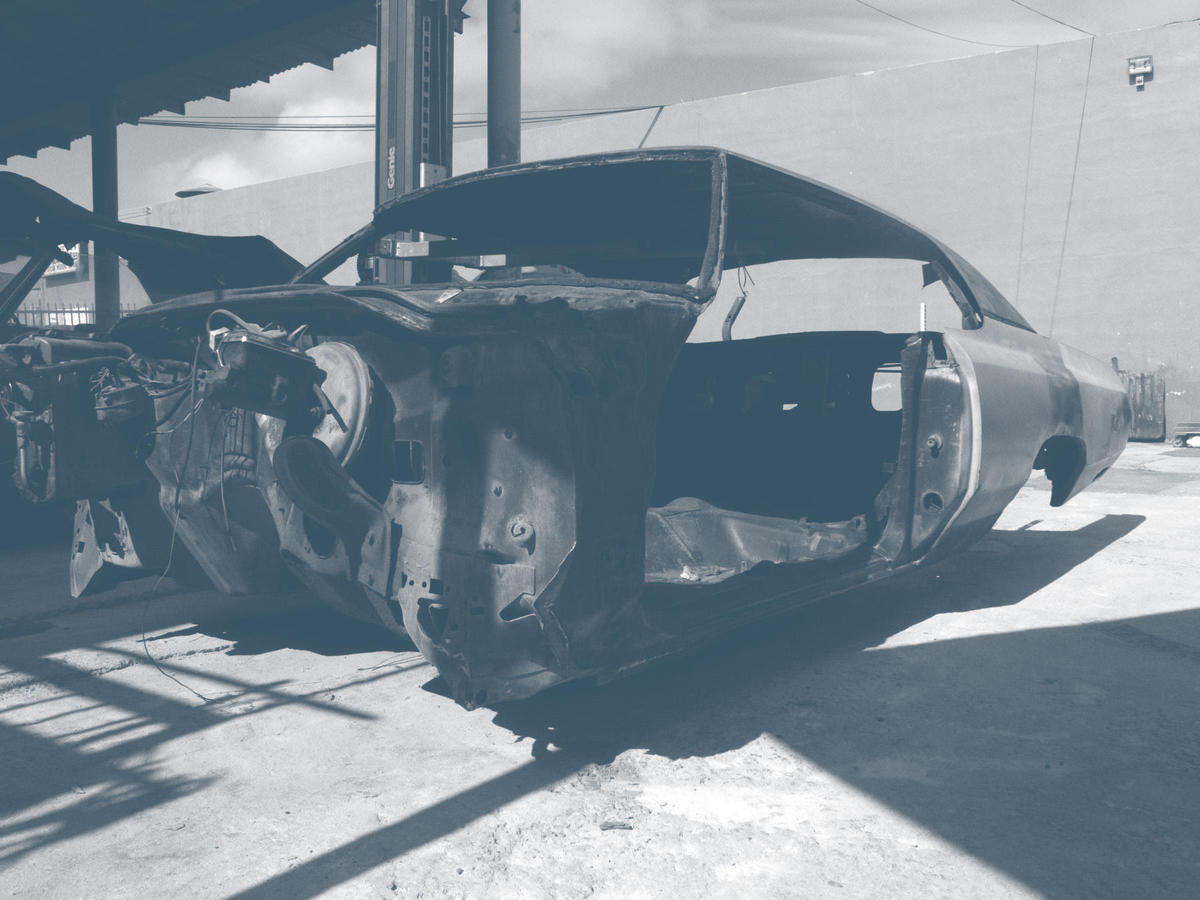
New York
Shadi Habib Allah: The King and the Jester
Reena Spaulings Fine Art
September 12–October 17, 2010
For his first solo exhibition in New York, Shadi Habib Allah presented a single video titled The King and the Jester, a loose portrait of an ordinary workday at the Perfect Auto Paint & Body Shop in Miami, Florida, where old-school, new-school, antique, and exotic cars are restored, rebuilt, recycled, candy-painted, and customized. Shot over a two-week period, the twenty-five minute video is by no means a traditional documentary of the shop’s personnel and productions, expert and dazzling though they appear to be. Rather, Jerusalem-born, New York-based Habib Allah angled his camera — and his pen — to produce an absorbing meditation-vérité on some of the shop’s more slippery subjects.
Deftly woven from both documentary and scripted footage (so revealed the press release), The King and the Jester possesses no clear narrative thread but still is thick with stories. We spy and eavesdrop on the shop workers, men with names like Red Dog, Overtown, Rico, and Booze, for whom foreignness, strangely enough, is a recurring topic of conversation. In one colorful exchange (heard as voiceover), two men wonder aloud about the sexual predilections of an unnamed culture. “Wonder how they fuck in their country,” one says. “Same way like we fuck,” is the matter-of-fact reply, which is followed by similar speculations about blow-jobs. In another sequence, two men discuss notions of heroism after seeing Werner Herzog’s Grizzly Man. “He lives his passion,” a man says, defending the fatal heroics of the film’s protagonist. “Why somebody gonna go to the war in Afghanistan or something?… . It’s people living a dangerous life, following their passion.” Later, another man complains bitterly about being called a “punk-ass little cracker” by some of his co-workers — an undeserved harassment, he explains, because he’s good at his job.
Habib Allah never reveals which sequences were observed and which were staged, and although viewers will very likely guess the origins of all the scenes correctly, the absence of visible seams — the lack of self-reference, of a wry eye — distinguishes Habib Allah’s video from the usual “art-world quarterbacking,” which finds too many artists profiling so-called subcultures only to assert the sovereignty of high art. (Mike Kelley and Michael Smith’s blue-chip spectacular A Voyage of Growth and Discovery, which incorporates performance videos shot at Burning Man, immediately comes to mind.) To clarify the point: one could just as easily imagine Habib Allah choosing to focus his attention on the shop’s custom paint jobs, or some other vocational element shared by both the auto and art worlds. Ham-fisted analogies could be conveniently forged and formal differences maintained until the video collapsed into a safe-and-dusty conversation between “high” and “low.”
But rather than arch, Habib Allah’s video feels immersive, integrating random, resonant details from around the shop — the rise and fall of a pair of glasses perched on a sleeping man’s chest, an American flag that hangs in tatters — with quieter frames in which one seems to see clearer portraits. And although the imposition of the author’s scripts onto the population of Perfect Auto is certainly a form of mediation, the strategy produces useful frictions between subject and character, and discreetly reminds us (when we remember to pay attention) that what we are watching will always be — even within the bounds of “purer” documentary strategies — a concoction, an interpretation, a director’s particular vision.
In one of the video’s more memorable scenes, Babba, the owner of Perfect Auto Paint, reclines on a couch and talks on his cell phone while an employee massages his bare feet. “Squeeze hard, man!” he commands, then bellows for a replacement when he feels his current “masseur” has failed to carry out orders. Scripted or otherwise, this scene is perhaps the most obvious hat tip to the video’s title as we watch Babba transform from king to jester — a boss who demands his feet be rubbed properly (“Like I teach you!”), and then acts the fool as he demonstrates for his employees how he will physically explode if they are not. Of course, the relationship between king and jester was traditionally one in which humor and, in some cases, madness allowed the jester to speak freely to the king, and in turn permitted the king to listen to fools. During their exchanges, their particular powers were inverted, truth and lies became interchangeable, and each functioned as a kind of mirror for the other. When Babba is accused by someone off-camera of not procuring a grill as promised, he swears that he can and will. “If I lie, I fly,” says Babba over and over again, a phrase cleverly echoed in the final shot of the video when Habib Allah’s camera pans up to a bird flying across the sky.
So could this be read as a clue to the identities of the video’s other kings and jesters? Documentary and fiction are, of course, inseparable sparring partners. Are, too, perhaps an artist and his subjects? The art world and its products? If I have one quibble with The King and the Jester, it is that many of its most potent themes are ultimately touched upon too lightly. Race, class, labor, power, foreignness — all of these undercurrents into which Habib Allah dips but never dives deeply — could have been addressed with greater force without losing the work’s essential lyricism. Bolder choices about how and why the artist decided on Perfect Auto Body — what he expected to reveal, and where his observations and intentions were upended — could have given rise to more pointed and powerful questions. Which is all to say that if The King and the Jester feels in moments to be a bit unfinished — less thoroughly engaged with its subjects and strategies than one would wish it to be — it’s more than likely because as an artist, Habib Allah is just getting started.